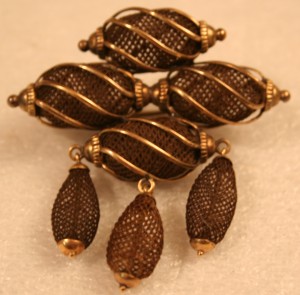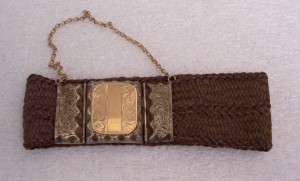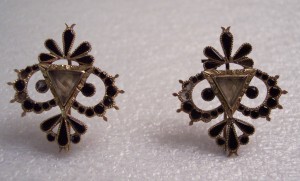The Litchfield Historical Society has a significant collection of mourning jewelry and many of the pieces were donated to the museum by the descendents of the individuals who owned the pieces.
 Mourning brooch made of human hair, 2006-41-1 Gift of Mr. and Mrs. Thomas Babbitt
Mourning brooch made of human hair, 2006-41-1 Gift of Mr. and Mrs. Thomas Babbitt
Mourning jewelry seems strange and even grotesque to many people today. If you are unfamilar with the term, mourning jewelry is a piece of jewelry constructed primarily of human hair. It was a very common practice for loved ones to exhange locks of hair. It was a tangible way for a person to be remembered in the days before photography. Throughout the late 18th and early 19th century, the recently deceased were often memorialized through the practice of taking a lock of hair and having it incorporated into a piece of jewelry. Rings, necklaces, bracelets and even earrings were made of hair. For men, watch chains and rings were popular forms. The bereaved were comforted by keeping a piece of their deceased loved one close to them.

Bracelet made of human hair, 1937-07-4, Gift of the William Colgate Estate

Pair of earring made of human hair and jet, 1923-04-6 Gift of Mrs. Edwards W. Seymour
It was a skill that many women practiced at home. Molds were sold and instructions were available through magazines like Godey’s Ladies Book which was published from 1830 to 1878. There were also businesses that formed in larger towns and cities that offered the service of creating mourning jewelry for the public. Mourning jewelry became especially prolific during the Civil War when many American households lost loved ones to battle and disease.
 Jewelry Box, C. Linherr Artist in Hair 577 Broadway New York City, Donor Unknown
Jewelry Box, C. Linherr Artist in Hair 577 Broadway New York City, Donor Unknown
This October, the Historical Society has a small display case in the Ching Reading Room of the Helga J. Ingraham Memorial Library which showcases some of the museum’s mourning jewelry collection. In addition, the case includes other artifacts and archives associated with mourning and the ritual of death.